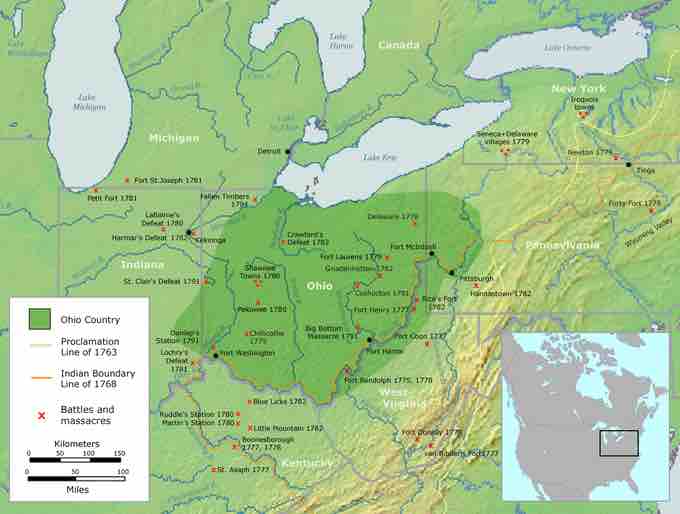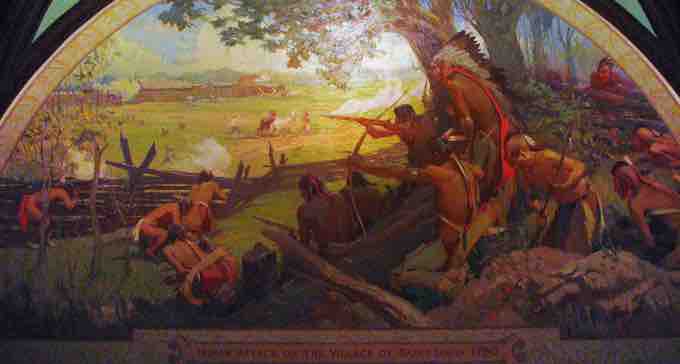The Revolutionary War in the west was fought primarily between civilian settlers and American Indians allied with the British. Geographically, the conflict was focused around Detroit, which was held by the British, and south and east of the Ohio River. When the American Revolutionary War began in 1775, the Ohio River marked a tenuous border between the American colonies and the American Indians of the Ohio Country. Ohio Indians—Shawnees, Mingos, Delawares, and Wyandots—were divided over how to respond to the war. Though some Native Americans were on friendly terms with settlers, many opposed the United States as a threat to their territory. Approximately 13,000 Native Americans, representing several Indian Nations, fought for the British.

Map of the Ohio Country
This map depicts the battles and massacres that occurred within Ohio Country between 1775 and 1794.
In 1763, the British Crown issued a Proclamation forbidding British colonists to settle west of the Appalachian mountain range. Settlers and land speculators in Britain and America objected to this restriction, leading to treaties with American Indians in 1768 that opened up land for settlement south of the Ohio River.
Most of the action in the West consisted of escalating series of retaliations between frontier settlers and local indigenous populations. Land disputes were common as territorial boundaries established by treaty were frequently not honored by both settlers and American Indian tribes. Shawnees, who did not take part in the treaties of 1768, organized a confederacy of western Indian Nations with the intention of preventing the loss of their lands. This confederacy gained strength in 1775, with the support of the British.
Early in the war, isolated settlers and hunters became frequent targets of attack, compelling many to return to the East. By late spring 1776, fewer than 200 colonists remained in Kentucky, gathered in a few fortified settlements. The situation escalated in 1777 as the British launched a major offensive into the west from Canada. In order to provide a strategic diversion for operations in the Northeast, the British in Detroit began recruiting and arming American Indian war parties to raid American settlements.
The intensity of the conflict increased as settlers retaliated. In 1778, settlers decided that offensive operations were necessary to secure their western border. Yet the first American expedition into the Ohio Country was a disaster, ending in a blundered attack on peaceful Delaware Indians. Over the next several years of the war, both sides launched raids against each other, usually targeting settlements. Patriot efforts to move against Fort Detroit were undermined due to the lack of ready troops and because escalating raids had created more determined enemies of the American Indians.
The year 1782 was famously dubbed "The Year of Blood" due to the level of cruelty displayed in the raids conducted by both settlers and American Indian nations. In one notorious incident in March 1782, called the Gnadenhütten massacre, a peaceful community of Christian Delawares were brutally executed by militiamen. The Delawares, numbering about 100 and mostly comprised of women and children, were executed by 160 Pennsylvania militiamen with hammer blows to the head. In a subsequent campaign led by Colonel William Crawford against American Indian communities along the Sandusky River in May 1782, Crawford was captured and tortured in retaliation for the Gnadenhütten massacre. Crawford’s execution was widely publicized in the United States, which worsened the already strained relationship between American Indians and European Americans.
In August 1782, British General Caldwell led 300 American Indians into Kentucky in the Battle of Blue Licks, delivering a devastating defeat to 182 militiamen in the state. The Battle of Blue Licks was one of the final battles of the American Revolutionary War and occurred 10 months after Lord Charles Cornwallis’ famous surrender at Yorktown, which had effectively ended the war in the east. It was also the worst defeat Kentuckians had experienced during the frontier war. Peace negotiations between the U.S. and Great Britain created a temporary respite in hostilities during The Year of Blood; but in November 1782, Brigadier General George Rogers Clark delivered the final blow in The Year of Blood, destroying several Shawnee towns in the Ohio Country.
The war in the northwest was essentially a draw. In the war's final years, settlements were destroyed on both sides, but territory could not be held once claimed. Although American Indians had been pushed back from the Ohio River and were now settled primarily in the Lake Erie basin, settlers could not occupy the abandoned lands for fear of further raids. In the final treaty between Great Britain and the United States, the Ohio Country was granted to the United States. Great Britain did not consult American Indians during the peace process, and local tribes were nowhere mentioned in the treaty's terms. For the American Indians, the hostilities would continue under a different name: the Northwest Indian War. The only difference between this conflict and the previous one was that the American Indians could no longer rely upon the explicit support of the British.

Indian Attack on the Village of Saint Louis, 1780
This mural depicts a British force, mostly consisting of American Indians, attacking St. Louis.